By Christopher Lehman, Literacy Professional
Information is everywhere. The amount produced in the three-year period from 1999 to 2002 was equal to the amount produced in the entire history of the world (Darling-Hammond, 2010). Our children are growing up in a time where it is essential to be an informed, engaged and critical learner.
That said, I know many of us struggle with the stacks and stacks of student projects, poster boards and slide presentations that feel more like lists of rehashed facts, then committed learning. Colorful collages of “life cycles” are full of plagiarized facts or lifeless paragraphs. Slide presentations about “Ellis Island” that seem to be directly lifted from the notes we gave them. Essays that nearly all look the same. These are not only a bore to read and a bear to grade, but are also an incredible disservice to our children and young adults.
When research and informational writing become only a means to copy down facts and shove them into paragraphs—the same facts a smartphone could look up in less than a second—then students are given repeated practice in low level skills. They build a habit the world does not need them to have. The good news is that it is not too difficult to move students from passive collectors of information to thoughtful researchers who engage critically and passionately with ideas. It begins with us.
Research Is As Research Does
In my book, Energize Research Reading And Writing, I offer several shifts and lesson ideas for the way we teach the process of research to students which move them to be active and curious learners. The first of which is 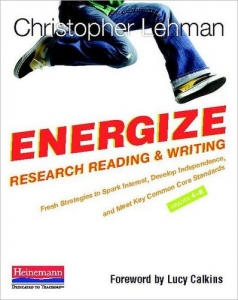 recognizing that research is something we all do all of the time: what to make for dinner, what book to read next, helping your mother deal with an illness, a solution to your pet’s fleas, who to vote for, where to go on your next trip, etc. These things are research. The habits you have are the same ones anyone who specializes in particular types of research have—be they scientists, authors, or deep sea divers.
recognizing that research is something we all do all of the time: what to make for dinner, what book to read next, helping your mother deal with an illness, a solution to your pet’s fleas, who to vote for, where to go on your next trip, etc. These things are research. The habits you have are the same ones anyone who specializes in particular types of research have—be they scientists, authors, or deep sea divers.
“Wait,” you might be saying, “in high school I stood at a card catalog for hours at a time, spent eight weeks on a ‘research project’.” So did I (and it was awful). That is not the type of research practice our students need today. Nor the type the Common Core is expecting (Writing Standard 7). Nor the type I am suggesting here.
Changing the Ways We Teach Research Skills for a New World
The ways we naturally research, especially when we do it well, are the exact habits we need to teach our students:
- In life, we rarely start with a fine tuned question. Instead, we tend to start with a general topic, hunch or broad inquiry. Such as: “I want to know more about whales, they are so majestic,” “Which cell phone should I upgrade to?,” or the always confounding, “Birthday gift for dad.”
- In life, we are never handed the just right set of the just right sources (though how many times do we wish we were?). Instead, we begin broadly reading, viewing and experiencing. Have a newborn? You must have more parenting books, websites and uninvited advice stacked up than you can carry. Only through the process of digging-in do you start to find which sources to trust (or not), which questions are more worth asking than others and where you most want to direct your energy.
- In life, we don’t copy down line after line from sources and people. Instead, we think. When we set out to learn we organize, question and synthesize the information we gather. That tropical vacation spot on television sounded perfect, until you read a website talking about the rainy season. We don’t plagiarize because we are thinking about our thinking.
- In life, we don’t have packets to fill out or graphic organizers to follow to prove we did our work. Instead, we are active with our research—we tell others, blog or go enact our new learning. We talk about the sides of a political issue we dug into. We go buy that super, perfect, impressive new phone. We swaddle our baby and shush in her ear.
The structure of any research study, long or short, becomes powerful when built around a natural process of learning. Research is not a product, I argue, it is a process. The stronger our students’ process becomes, naturally their products will develop as well.
Give Your Students Choices and Time for Curiosity
If our students are to research in more authentic ways, then we need to provide more authentic experiences.
Provide Choices of Topics and a Wealth of Texts
As I describe in Energize Research Reading And Writing, whether offering students the opportunity to explore any topic or limiting them to a topic within a content area you are studying, say for example US Government, providing choice is an essential component of engagement and independence.
That said, gone are the days where your classroom library can have a random collection of “nonfiction” books. Instead, plan to organize texts within topic areas so your students can lead their own, deep studies. When you collect texts, look for a range of levels and coverage (broad “all about” books and ones that offer specific slices). This way you can teach your students to both choose topics and make real-world decisions about which texts to select and how to use them. Here is an example:
| Topic | Read First | Read Second | Read Later |
|---|---|---|---|
| Abraham Lincoln | Abe’s Honest Words by Doreen Rappaport because it is short, a full overview, and supported by beautiful illustrations. | Chasing Lincoln’s Killer by James L Swanson because…well because it’s awesome. Also because it takes just one slice of this topic. | Skim the glossary of Lincoln: A Photobiography by Russell Freedman because it is lengthy, but also in-depth on a variety of topics. |
| Whales | Whales And Dolphins from Kingfisher’s Explorers series because it provides an easy to navigate, all-about overview. | Whales by Seymour Simon because it continues an overview, but provides more domain-specific vocabulary and concepts. | Skim the glossary of The Secret World Of Whales by Charles Siebert because it covers many unique topics and facts. |
| Our Universe | The Universe by Seymour Simon because it offers an overview of the topic. | Get interested in one slice of the topic after reading the first book, and move to A Black Hole Is NOT A Hole by Carolyn Cinami DeCrisofano. | The Mysterious Universe: Supernovae, Dark Energy, And Black Holes by Ellen Jackson because it becomes more technical and specific. |
| US Government | How The U.S. Government Works by Syl Sobel because it provides a student friendly overview. | Skim D Is For Democracy by Elissa Grodin because it is organized alphabetically not by content, yet provides a wealth of information and engaging illustrations. | Skim (though many students can’t put down) What Are My Rights? Q&A About Teens And The Law by Judge Tom Jacobs because it sneaks in facts about the law while giving answers to teen’s questions. |
Of course, go beyond texts as well, to help students include Internet sites, hands-on experiments, television and even interviews. Stephanie Harvey and Harvey Daniels offer terrific suggestions on making multi-sensory texts sets in their book Comprehension And Collaboration: Inquiry Circles In Action.
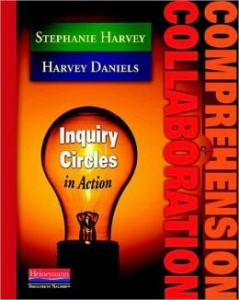
Provide Time for Curiosity
In addition to resources, provide the time students need for curiosity. The heart of research is wondering about life. This should not just be confined to one long project, but instead grab small moments throughout the school week to stop and wonder. I suggest learning more about Genius Hour (there are tons of resources online) or National Center of Families Learning’s Wonderopolis.
When research looks and feels more like the ways we authentically learn and explore, our students are more engaged, their work becomes more rigorous and thoughtful and we build a better future for all of us.
Written by Christopher Lehman, an international consultant, educator, author and popular speaker. He can be found online at his blog ChristopherLehman.com, twitter @iChrisLehman, and in guest posts in EdWeek, SmartBrief’s Smart Blog on Education, among others. You may also find him cooking something yummy in someone’s kitchen when he has a free moment. His recent book, co-authored with Kate Roberts, Falling In Love With Close Reading: Lessons For Analyzing Texts—And Life is available now.




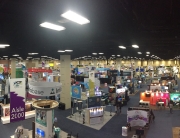
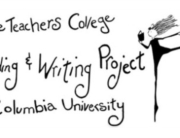
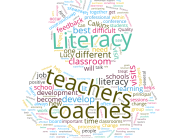
Leave A Comment